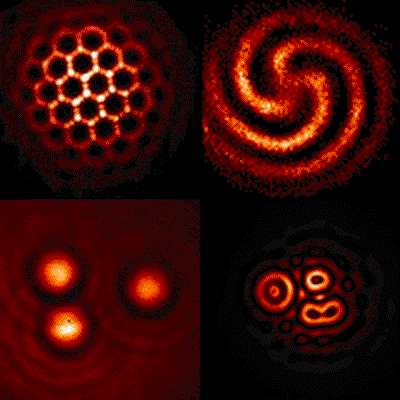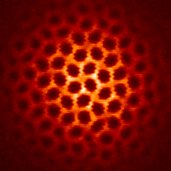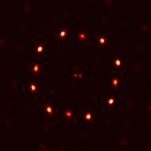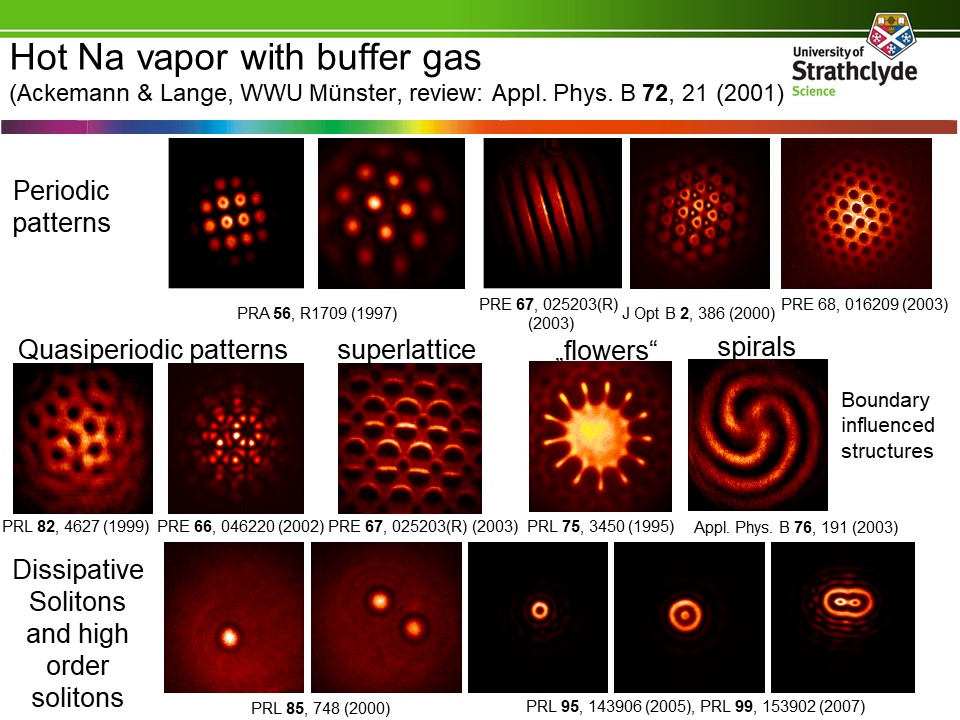Optical Pattern Formation in hot Na vapour

Introduction
Nonlinear effects occur in many media and in many different configurations. Concerning the medium, we focus on experiments using sodium vapour. The nonlinearity is due to optical pumping. Beside technical advantages (high optical quality, easy variation of parameters over a broad range, high resonant nonlinearity) the benefit of using an atomic vapour is that the equations governing the light-matter interaction can be derived directly from quantum mechanics via the density matrix approach. A large buffer gas presure of molecular nitrogen ensures that atomic motion can be simply decsribed by diffusion and that depolarization from radiation trapping is negligible.Regarding the investigated configurations, investigations have been done in most of the situations in which spatial optical structures are known to occur. Since we are interested in the fundamentals, we work in a so-called single-mirror feedback system because of its conceptual simplicity.
Main results
Our experiments yielded:
- Report on the observation of nice hexagonal structures in this system (PRA 1994).
- Further indications for spontaneous summetry breaking: The video below show the real-time dynamics as observed with a CCD-camera at video rate of the far field image (i.e. Fourier spectrum) of the asymptotic structure at constant pump power. Centre: pump; off-axis: spontaneousm sidebands forming the hexagons. One observes noise-driven jitter around metastable position with occasional jumps to other metastable positions positions as one expects for rotational symmetry broken by small experimental imperfections.
- The first demonstration of a secondary instability of a hexagonal pattern due to a two-dimensional wavevector resonance at $\sqrt{3}$ of the original wavenumber (PRL 1995).
- The first detailed investigation and interpretation of polarization patterns (PRA 1997), (J Opt B 2001).
- The demonstration of intensity spiral and target patterns in a rotationally symmetric system but with a radially varying control parameters (APB 20003).


Slow motion picture obtained by sampling method
- The demonstration that there is a finite locking range if drifting patterns are to be induced by a tilt of the feedback mirror and its interpretation (PRA 1997).
- The demonstration of spontaneous quasiperiodic patterns with a twelve (PRL 1999) and an eight-fold (PRE 2002) rotational symmetry by a spontaneous breaking of the rotational symmetry.
- The demonstration of a new type of a self-organized superlattice (PRE 2023).


Left: real space; Right: Fourier space
- The observation of triangular structures, very elusive in dissipative pattern formation (J Opt B 2000).
- A careful analysis of the properties of dissipative solitons, i.e. self-localized structures. In particular, we provided first experimental evidence for the existence of multiple, discrete distances in clusters of dissipative solitons due to interactions via oscillating tails (PRL 2000).
- The first experimental demonstration of a discrete family of high order dissipative solitons (PRL 2005).
- The first experimental demonstration of a $ t^{0.5} $ growth law for the coarsening of domains of equivalent states nested in each other and how these lock to form localized structures (PRL 2007).
The experiment is discontinued but I am very happy to discuss any questions. A review can be found in APB 2001.

Examples for structures obtained in atomic vapour cell with optical feedback.
People
Over the years (1994-2007), many people contributed to the success of these investigations at the University of Muenster (Germany):
- PI: Thorsten Ackemann, Wulfhard Lange
- Postdocs: Ramon Herrero, Yuri A. Logvin
- Postgraduate students: Andreas Aumann, Florian Huneus, Edgar Grosse Westhoff, Matthias Pesch, Burkhard Schaepers, Jens Seipenbusch, Jens Schuettler
- Undergraduate students: Burghard Berge, Monika Boelscher, Marc Feldmann, Benedikt Giese, Andreas Heuer, Volker Kneise, Daniel Rudolph, Jens-Uwe Schurek, Michael Tegeler
Collaborators
- IMEDEA (Palma de Mallorca): Damia Gomila, Pere Colet
- University of Strathclyde: Thorsten Ackemann, Willie J. Firth, Gian-Luca Oppo
Funding
We are grateful for funding by the Deutsche Forschungsgemeinschaft and the Deutsche Akademische Austauschdienst.